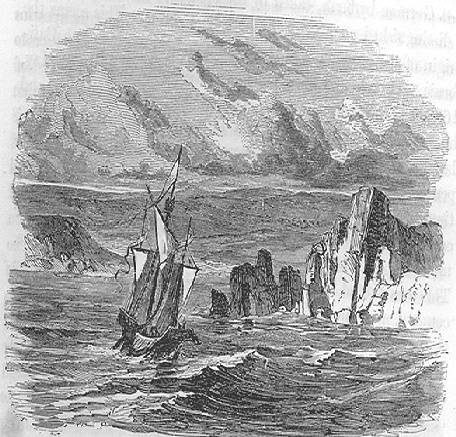EXPLORATION OF BAY (1772-76)
Historical Essay
by K. Maldetto
Engraving of the hazardous entrance to the Bay
After Portolá's accidental discovery of San Francisco Bay in 1769, exploration of the region only resumed in 1772. Amazingly, the main objective of the new expedition was finding a way around the bay to facilitate the foundation of a mission at the clearly inferior bay named by Cermeo, in 1595, Bahia de San Francisco (today's Drake's Bay). Pedro Fages, captain during the 1769 De Portolá expedition, led the outing which left Monterey in March 1772. Fages and his men travelled on the eastern shore of the Bay through present-day Oakland and Berkeley. Unable to cross the Carquinez Straits, they continued along the shore of the bay until they reached the region of modern-day Antioch at which point the party, frustrated with its incapacity to reach Cermeo's bay, retreated to Monterey. The Fages expedition, while not resulting in any settlement, was nonetheless significant in that it marked the first European contact with Bay Area Native Americans.
A second small expedition was led by Rivera y Moncada, another one of Portolá's aides, at the end of 1773 to locate possible mission sites. However, the next significant exploration of the San Francisco Bay did not occur until two years later under the command of Lieutenant Juan Manuel de Ayala. On August 5, 1775, Ayala, in command of the ship San Carlos, became the first European to sail through the Golden Gate, after over two centuries of regular navigation along the California coastline!
The Spanish authorities were convinced that Cermeo's Bahia de San Francisco (today's Drake's Bay) and San Francisco Bay "discovered" by Portolá were in reality one and the same bay. Ayala's mission was hence to explore San Francisco Bay and find the strait that linked it to Cermeo's Bahia de San Francisco. Of course he never found it, yet during his sojourn Ayala came to the more important realization that San Francisco Bay was not only a port clearly superior to Cermeo's but was also one of the best in the world.
Ayala spent 45 days in the bay, mostly at anchor off of Angel Island waiting for an overland expedition, led by Rivera, which was nowhere in sight. While waiting for Rivera, and recovering from an accidental shot to the foot, Ayala put his free time to good use by keeping a detailed log of the trip and giving many of the islands of the bay their present-day names. The island he was anchored off he named Isla de los Angeles in honor of Our Lady of the Angels. For some time the island was known as Los Angeles Island, but today it is known more simply as Angel Island. Ayala named the other large island of the bay (today's Yerba Buena Island which serves as the mid-point of SF-Oakland Bay Bridge) Isla de los Alcatraces, or Alcatraz Island, for the numerous pelicans he saw there. Today's Alcatraz Island, Ayala originally named Yerba Buena by for the herb yerba buena which was growing wild on the island. A British sea captain named Frederick Beechey, mapping the bay in 1826, accidentally switched the two names and the islands have kept these inverted names ever since.
Once he had finished surveying the bay and still seeing no sign of the land expedition, Ayala decided to return to Baja California. The Ayala expedition was important in two respects: for one it proved conclusively that Drake's Bay and San Francisco Bay were two separate bodies of water and established San Francisco Bay as a port of great importance; secondly it marked the beginnings of European settlement along the bay's shores.
--K. Maldetto
Further Reading:
Bancroft, Hubert Howe, History of California, Volume I, 1542-1800, Publisher Wallace Hebberd, 1963 (first published 1886).
Bean, Walton and Rawls, James, California: An Interpretive History, 5th ed., McGraw-Hill, 1988.
Chapman, Charles E., History of California: The Spanish Period, MacMillan, 1949 (first published 1921).
Costans, Miguel, The Discovery of San Francisco Bay, The Portolá Expedition 1769-70 (Diary of Miguel Costans), Great West Books, 1992.
Lewis, Oscar, San Francisco, Mission to Metropolis, Howell-North Books, Berkeley, 1966.
Charles Wollenberg, Perspectives in Bay Area History, UC Berkeley Press, 1984.


